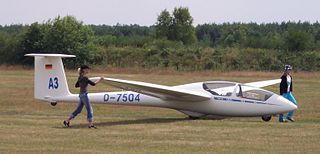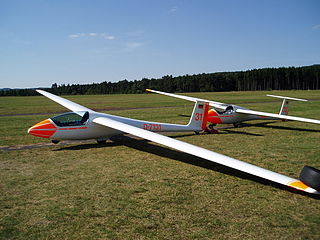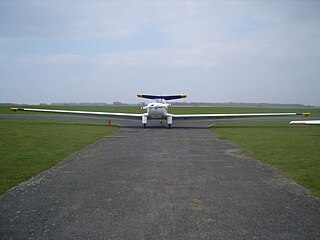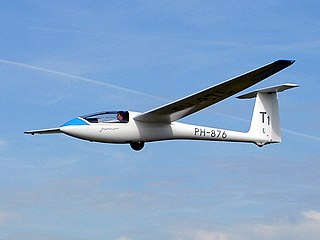
Grob Aircraft is a German aircraft manufacturer, specialising in gliders and general aviation.

The Rolladen-Schneider LS4 is a Standard Class single seat glider manufactured by Rolladen-Schneider Flugzeugbau GmbH between 1980 and 2003.

The ASK 21 is a glass-reinforced plastic (GRP) two-seat glider aircraft with a T-tail. The ASK 21 is designed primarily for beginner instruction, but is also suitable for cross-country flying and aerobatic instruction.

The ASW 19 is a single-seat glider built by Alexander Schleicher GmbH & Co, first flying in 1975. It was originally designed as a Standard Class glider, but now mainly competes in the Club Class. The ASW 19 is known for its pleasant handling and some clubs use it as a training glider. It was succeeded by the all-new Schleicher ASW 24.

The G102 Astir is a single seat glassfibre Club Class sailplane, designed by Burkhart Grob and built by Grob Aircraft. It was the first Grob-designed sailplane, with the first flight in December 1974. Grob had previously built the Schempp-Hirth Standard Cirrus under licence.

The Grob G109 is a light aircraft developed by Grob Aircraft AG of Mindelheim Mattsies in Germany. It first flew in 1980. The G109B followed in 1984. It is a two-seat self-launching motor glider in which the pilot and passenger or student sit side by side, with good visibility provided by large windows.

The G103 Twin II is a high-performance two-seat sailplane manufactured in Germany by Grob Aircraft. The aircraft is of T-tail configuration, and is fitted with upper-surface airbrakes and a non-retractable undercarriage. Of fiberglass construction, it is designed for training, high performance cross-country racing and simple aerobatic flying.

The Schleicher ASK 18 is a single-seat sailplane that was built by the German manufacturer Alexander Schleicher GmbH & Co. It was designed to be a sturdy aircraft for inexperienced solo pilots and so uses a simple and rugged construction and has docile handling characteristics.

The Schleicher ASK 23 is a single-seat Club Class sailplane that was built by the German manufacturer Alexander Schleicher GmbH & Co.

The Grob G104 Speed Astir was a competition sailplane produced in Germany in the late 1970s as Grob's first design in the 15 metre class. Taking the G102 Astir design as a starting point, the Speed Astir featured a new wing of narrower chord and different section, a fin and rudder of reduced height, capacity for 150 kg (330 lb) of water ballast, and "elastic flaps". This latter feature eliminated the drag normally associated with the air gap between the wing and a deployed flap. It did this by extending the wing skin over the entire upper surface so the highly flexible skin served as the flap hinge and there was no air gap between the flap and the remainder of the wing.

The ICA IS-28 is a two-seat sailplane produced in Romania in the 1970s. An all-metal aircraft of conventional design with a T-tail, it was originally produced with 15-metre wings, but in 1973, production shifted to the IS-28B with 17-metre wings and numerous aerodynamic refinements. These included a smaller tail with decreased dihedral, decreased dihedral on the wings, and redesigned fuselage contours. This version first flew on 26 April 1973 and was subsequently produced in versions with flaps (IS-28B2) and without (IS-28B1). Around 100 had been built by the early 1980s, with a substantial number sold for export. On April 7, 1979, Tom Knauff and R. Tawse set a world record with the IS-28 B2 glider, covering a distance of 829 kilometres on a predetermined out-and-return course from the Ridge Soaring Gliderport in Julian, Pennsylvania.

The T.31 Tandem Tutor is a British military training glider, designed and built by Slingsby and used in large numbers by the Air Training Corps between 1951 and 1986.

The Slingsby T.21 is an open-cockpit, side-by-side two-seat glider, built by Slingsby Sailplanes Ltd and first flown in 1944. It was widely used by the RAF, Sri Lanka Air Force and by civilian gliding clubs.
The Torva 15 was a single-seat glider designed and built in United Kingdom from 1970.

The Glasflügel 205 Club Libelle is a high wing, T-tailed, single seat glider that was designed and produced in West Germany by Glasflügel for club and rental use.

The PZL Bielsko SZD-51 Junior is a Polish single-seat training and club sailplane.

The PZL Krosno KR-03 Puchatek is a Polish mid-wing, T-tailed, two-seats-in-tandem, glider that was designed by Jerzy Krawczyk and Eugeniusz Pelczar and produced by PZL Krosno, first flying in 1985.

The Akaflieg Stuttgart fs31 Ferdinand Porsche is a tandem seat, dual control training glider designed and built in Germany between 1977 and 1981. The aircraft was intended to have high performance, yet to be robust enough for student use. It was not intended for production and remains in service with the Akaflieg after almost 40 years and 7,100 flying hours.
The Centrair 201 Marianne is a training glider seating two in tandem, designed and built in France in the 1980s. It was intended to replace the numerous but ageing gliders equipping French gliding clubs; when Centrair ceased trading in 1988 some eighty Mariannes had been sold, fewer than hoped.

The G103C Twin III is a high performance tandem two-seat sailplane made by Grob Aircraft. It replaced the Twin II in production and features a new triple-trapezoidal wing, automatic elevator connection, lower control forces and higher airspeed limitations.



















